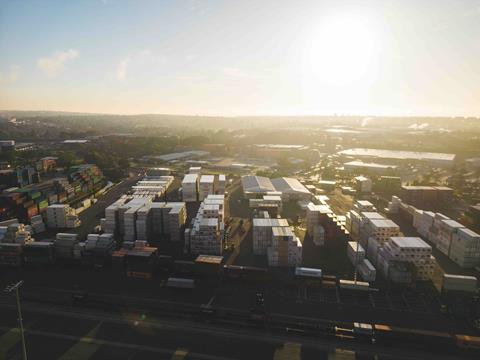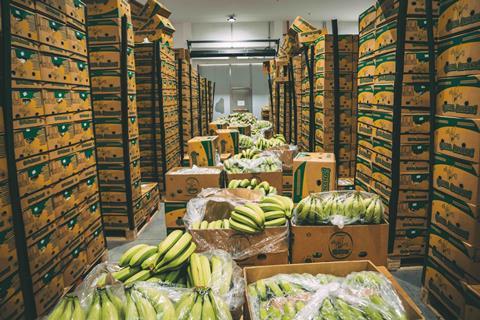Alfred Whitman, DP World’s global vice president and vertical lead – perishables, explains how global supply chains are shaping fresh produce trade and how his company is working to enhance efficiency in an increasingly challenging logistics environment
How do you see the current state of the fresh produce supply chain, particularly in Asia? Are you still seeing global challenges such as geopolitical and tariff disruptions impacting supply chains? Or is this easing somewhat?

Alfred Whitman: There are significant challenges persisting for the fresh produce trade, particularly in terms of supply. Across the end of 2024, we saw climate-driven cost inflation increase in markets such as China and Thailand, and while that is slowing, we’re anticipating supply-side frictions for years to come.
It’s precipitated by factors which include disease (which we’ve seen in some banana crops) and extreme weather conditions which, according to the FAO, have increased spoilage by up to 10 per cent. We also can’t discount the impact of continuing geopolitical tensions creating challenges in trade routes.
In some key markets for fresh produce supply, labour shortages are having an impact on the volumes available. In Thailand there is a shortfall of 400,000 labourers, heightened by the recent border conflict with Cambodia.
And, of course, trade tariffs have caused a lot of uncertainty.
How has DP World been working to improve its services to the fresh produce industry through this period?
AW: We’ve been working to improve the resilience of our supply chain operations in several ways. One of the most crucial developments is the advancement of port-centric solutions.
For example, we have Australia’s biggest reefer hub in Sydney, which can pre-trip and wash more than 100 reefer containers a day. In Malaysia, we have just built a cold store in Sapangar, improving lifespan of fresh produce moving through the region.
Cold store projects will be absolutely vital in driving resilient fresh produce supply chains, so the expansion of cold storage solutions is also underway in Egypt, India and Romania. In 2026, we will be building further facilities in locations such as Jeddah, Saudi Arabia.
Intermodal capabilities are playing an increasing role in resilience, offering agility in supply chains when they’re impacted by disruptions.
In New South Wales, Australia, we have a rail solution which is taking 100 trucks off the road a day, while in Limpopo province, South Africa, we are working on a reefer freight rail connection for citrus all the way through to Maputo, rather than shipping it via Durban, cutting its journey length considerably and ensuring it reaches its destination faster.
Barging solutions are also key to our intermodal capability. In November 2025, we will be launching a new short sea service from Agadir, Morocco to London that will cut the transit time from ten days to five. Produce like tomatoes – Morocco supplies 40 per cent of UK tomatoes – will now reach UK shelves with five more days of freshness.
Across the supply chain industry, the importance of leveraging data-driven insights to enhance services is ever-growing. One of our objectives is to continue to help reduce spoilage through data gathering and real-time visibility across the supply chain.

How important is infrastructure development to the improvement of the fresh produce supply chain in Asia? Or can gains also be made with service improvement and new technology?
AW: Infrastructure development across Asia is inconsistent compared with some other regions, and this is something we need to mitigate. Twenty-five years ago, I was working in China, and the landscape is different when we look at today. While coastal China is extremely mature, it is a different story for some inland locations.
For example, in places like Cambodia, there is still considerable work to be done to ensure the fresh produce supply chain operates efficiently and with resilience to external factors.
According to FAO data, 50 per cent of spoilage comes from between farm gate and retail and managing that is about gathering real-time data and being able to respond to any temperature fluctuations.
There is also merit to sharing the data across the value chain. We want to help companies streamline the way they operate, and the next big thing is how can we leverage technology to clear goods faster. However, one of the main challenges I see across multiple countries from Asia to Europe is lengthy documentation processes, even for ultra-fresh produce, but automating our processes will most definitely improve transit times. The message we want to convey to customs authorities across multiple countries is the value of leveraging innovation to speed up sanitary and phytosanitary clearance and reduce human error.

We’ve seen a lot of recent logistics capability development in Latin America. Do you think this will help improve fresh produce trade to Asia?
AW: The west coast of Latin America is a significant and evolving market for fresh produce sales in Asia. Thanks to our terminal in San Antonio, Chile, we are supporting a direct service from South America to Busan, Korea. It will be a game changer for moving fresh produce as it will also enable ocean to air solutions through our strong airfreight setup for perishables in Korea. That direct service is going to cut transit time significantly.
On the west coast of Latin America, we have invested in comprehensive infrastructure at origin. For example, we already have cold stores in Peru and Ecuador and plans are underway to build another in Chile, increasing the lifespan of fresh produce.
What trends are you seeing in Asia’s fresh produce sector at the moment?
AW: In Asia, the demand for premium fruits like berries is still rising and, as a result, we are seeing more intra-Asia trade. This trade has reached over 15.6mn tonnes already and so we are working on the development of services to support it, whether that’s leveraging our short sea services intra-Asia or working on new services, like delivering durian from Bangkok to China via rail.
There is also a convergence of standards in Asia, which is helping cross-border trade. The ASEAN-Japan blockchain guidelines are slowly but surely being adopted by countries like Thailand, Vietnam, and Malaysia, leading to less disruption caused by differing requirements.
Other growing trends include the rise of e-commerce, especially in markets like Hong Kong, where 25 per cent of produce sales are made using e-commerce platforms; and the increase in regulators and retailers asking for more CO₂ footprint data as they seek to decarbonise their operations and reduce Scope 3 emissions.

With an increasing focus on sustainability, how is DP World working to adapt the fresh produce supply chain to reduce waste and carbon footprint?
AW: Decarbonisation can be supported by leveraging leaner supply chains. A good example is our Agadir to London service, which is a faster and more sustainable route to market.
Cutting spoilage cannot be solely managed at the start of the value chain with grading and pre-cooling. Critical to ensuring this is minimising mismatch between what the grower is shipping and what the destination market is asking for. For example, sending grapes with 70 per cent MRLs to a retailer that is only asking for 60 per cent is a clear mismatch in supply and demand. By having a footprint that extends from origin to destination, and local market experts that can help shape global supply chains, we’re addressing sustainability at both ends.
Looking ahead, DP World is committed to leading the trade to net zero. Having already achieved a 13 per cent emissions reduction since 2022, we are working towards becoming a net-zero logistics business by 2050, with clear interim targets for 2030.



